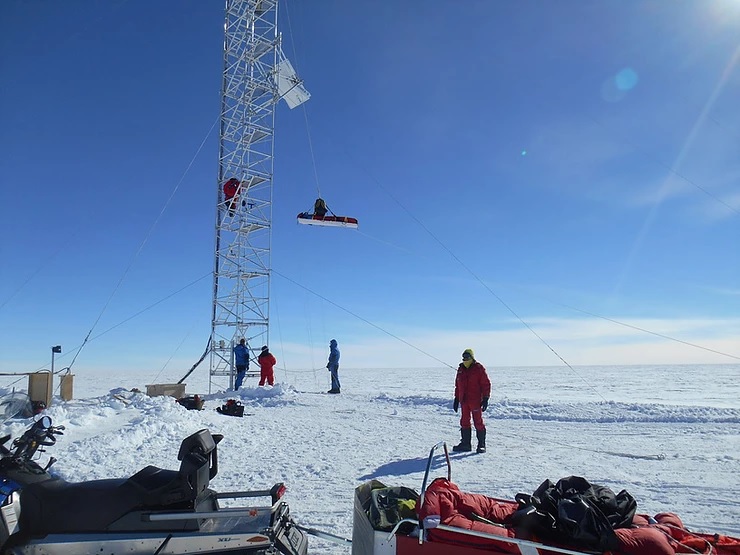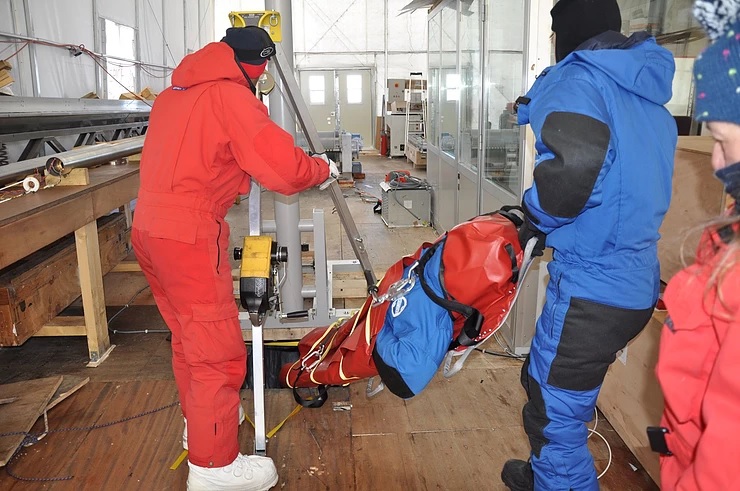Dr. Nadja Albertsen is the ESA-sponsored medical doctor spending 12 months at Concordia research station in Antarctica. She facilitates a number of experiments on the effects of isolation, light deprivation, and extreme temperatures on the human body and mind. In the following post, Nadja walks us through a day in the life of Concordia.
Every summer, an expert in rescue services in remote areas visited Concordia. Last year, it was the head of the medical section of the French Polar Institute, but this year we were trained by an alpine guide from the Italian military.
At Concordia there is a 45-m-tall tower known as the American Tower. It is primarily used for meteorological and glaciological studies and therefore lies just over 1 km from the base to reduce interference. The tower has gauges mounted from the base to the top and is cared for by two of my colleagues who must regularly inspect and clean the instruments all year round. This means that they go out and climb the tower, even during the winter when the temperature drops. There are some exceptions though: when the wind is too strong (about 7–8 m/s) no one is allowed on the tower.
Precautions are taken to prevent anyone from falling from the tower. Everyone who goes up the tower staircase must wear a climbing harness and rope. Despite these precautions, accidents can still happen, and that is where rescue training comes in.
Rescues in such places are not quick. It takes time to get the stretcher to the tower, to get ropes mounted, to get the stretcher up and get a person on the stretcher when you have extremely limited space inside the tower itself. The person must then be hoisted down and transported back to the base. And the latter is likely to happen by pulling the stretcher, as the snowmobile’s engine in the winter cold will probably only be able to sustain the trip to the tower.
You can imagine how this rescue takes more than 10 minutes. It is why the main thing we talk about is prevention, prevention and prevention.
In certain parts of the base we must always be accompanied by a colleague and the tower is one of these areas. Should anything happen to someone, their colleague can make sure that the injured person is protected from the cold while help is on the way. There are sleeping bags, heat bags and hot plates placed in all shelters on the base, including the tower.
Another place where rescue can become a serious challenge is in the seismological shelter (“the Sismo cave”). Like the tower, it is located about 1 km from the base to avoid tremors from heavy vehicles. Most of the measuring instruments are also located several meters underground. Should there be an accident where a person cannot make it back up on their own or with the help of another person, he or she would have to be hoisted by stretcher over two levels using special equipment and manpower (for example, a demountable-pull winch).
The easiest part of rescue training is the 7.2 meter jump. In the event of a fire, for example, we need to be able to quickly exit Concordia. To do this we slide down a tube, preferably not head first. This has been attempted before with poor results.
I can report that we all survived.
To read Nadja’s adventures at Concordia in Danish, see her personal blog.







Discussion: one comment
Thanks for this nice view in some of the daily and practical concerns while working in this invironment.